Polymarket Lands $2 Billion Investment from NYSE Parent ICE at $9 Billion Valuation

The parent company of the New York Stock Exchange, Intercontinental Exchange, has made a landmark investment of up to $2 billion in Polymarket. This is after valuing the decentralized prediction platform at $9 billion. Many experts believe this investment signals a growing connection between blockchain innovation and Wall Street.
From Startup Experiment to Institutional Backing
Polymarket began quietly in 2017, created by founder Shayne Coplan as a place where crypto users could trade opinions on real-world outcomes. At first, the concept seemed niche; bets on elections, global events, or economic data priced by market consensus. But the idea caught on. Traders started using these markets as a faster way to read public sentiment than polls or forecasts. Now, with ICE involved, Polymarket’s valuation has skyrocketed from just over $1 billion earlier this year to $9 billion, giving it institutional legitimacy that few DeFi projects have achieved.
This investment, and plans for using decentralized technology in traditional financial systems, come as governments continue to set clearer regulations around crypto assets. With these changes, decentralized assets are now more broadly accepted and used across borders. The same tokens that drive blockchain markets can now buy property in a different country, trade on U.S. exchanges, or be used for entertainment, even at international gaming platforms like poker sites in Malaysia where players can enjoy loads of poker formats, frequent tournaments, and generous bonuses. Many users prefer paying in cryptocurrency because transactions are instant, fees are low, and personal details remain private. This is especially well-liked in online recreational sites where players want to set up their accounts quickly and play anonymously. As more people use crypto in varied ways, these tokens are becoming less a speculative asset and more a practical currency for daily transactions.
Scrutiny, Setbacks, and a Turn Toward Compliance
Polymarket’s path to prominence hasn’t been smooth. Less than a year ago, the FBI searched Coplan’s home during an investigation tied to a past regulatory settlement. Instead of retreating, the company moved to strengthen its legal standing. In July, it acquired QCEX, a CFTC-licensed exchange and clearinghouse, giving it an approved route to operate in the U.S. market, helping Polymarket to attract more institutional money. Soon after, it secured funding from 1789 Capital, which drew additional attention from both political and financial circles.
Prediction Markets Gain Respect in Finance
Long dismissed as experimental, prediction markets are starting to win recognition as useful indicators of public sentiment. Analysts say they often anticipate market reactions faster than traditional data sources. With ICE’s endorsement, Polymarket’s data could soon become part of broader financial analysis. Polymarket’s main competitor, Kalshi, also recently hit a $2 billion valuation. That said, the plans put into place with ICE leave Polymarket well ahead, both in visibility and valuation. In an effort to make real-time market sentiment accessible to traditional traders, ICE has put out plans to distribute Polymarket’s event-driven data to financial institutions within its global network. This move is seen as ICE’s strongest step toward integrating decentralized forecasting tools with established financial systems.
Blurring the Line Between Traditional and Decentralized Finance
The ICE–Polymarket deal illustrates how traditional exchanges are no longer viewing blockchain projects as rivals but as collaborators. Regulation has created a framework where digital and conventional markets can coexist more easily. Assets once seen as speculative are now recognized as legitimate investment vehicles. Another aspect of this is cross-border compatibility, which allows digital assets to circulate freely between countries without constraints of legacy banking systems.
Conclusion
Polymarket has become a leading blockchain firm after ICE’s $2 billion investment. Its appeal lies in the mix of transparent, fast decentralized data and the reach of a global exchange operator. As regulations evolve, the gap between crypto and traditional finance keeps shrinking, marking blockchain’s growing role in global markets.
You May Also Like

USDC Treasury mints 250 million new USDC on Solana

Build a Crypto Exchange With USDT and USDC Transfers On Solana
- Quick transfer Solana’s blockchain is so fast that transactions in USDT and USDC can happen in just a few seconds. The fees are also much lower than those on the Bitcoin and Ethereum networks.
- Liquidity market By giving unstable assets a stable trading pair, stablecoins make exchanges more liquid. This makes it easier to buy and sell things and brings more people into the market.
- Fiat Currency Utilization People who are new to crypto can easily trade USDT and USDC for fiat money because they are based on USD and settle quickly.
- Less Price Fluctuations Adding stablecoins to your exchange lets traders keep their profits safe from price changes in cryptocurrencies without leaving the blockchain.
- Defi Management You can lend, stake, and farm with stablecoins on Solana’s DeFi platform. This means that your exchange can do more than just trade; it can also offer full decentralized finance solutions. Things to be Considered While Using Solana as a Cryptocurrency Trading Platform To make sure that trading on your Solana crypto exchange is safe, quick, and easy to use, it needs to have these important features:
- Efficient Trading Engine A good trading engine makes sure that orders are matched quickly, with little delay, and with a high level of dependability. This is very important for traders who make a lot of trades at once.
- Productive Wallet Management Give users wallets that can hold USDT, USDC, and other Solana-based tokens and are safe. These wallets should be able to encrypt things, keep them in cold storage, and have more than one signature.
- Liquidity Pool Management Make liquidity pools and market makers work together to keep order books stable. This lets people trade without prices changing too much.
- Advanced Security Architecture There is a limitless boundary for a variety of security options, like anti-DoS protection and multi-factor authentication. It will keep all the information safe and secure.
- Live Report Analysis The Solana blockchain uses lively interactive dashboards that feed the present market situation on a timely basis. This allows users to make a quick decision on the token to be traded first.
- Adoption of “Know Your Customer” Policy This policy is framed based on the latest crypto standards and users can have full authenticity with this policy. It prevents threats like anti money laundering.
- Blockchain Platform Compatibility People should be able to easily access and trade on your exchange from the web, mobile devices, and desktop computers.
- Timely Transaction Settlement The Solana network is very fast, so transactions with USDT and USDC settle in seconds. This makes users happier and more likely to trust it. Technical Benefits of The Solana-Based Crypto Platform High Frequency Transaction: Solana is a powerful blockchain that processes millions of transactions in seconds and hence there are high chances of earning profit. Scalable: The particular blockchain is capable of withstanding the trading activities of numerous users. Low Gas Fees: Transactions on Solana are cheap and easy to understand. When the Ethereum network gets busy, gas prices go up, which is not the case with this. This is why Solana is a great place to trade stablecoins. Energy Efficiency: The proof-of-stake system on Solana uses a lot less energy, which is better for the environment. Connecting to DeFi and Web3: It’s simple to connect your exchange to decentralized finance protocols, NFT platforms, and Web3 tools when you build on Solana. This gives your exchange more features. Build a Decentralized Crypto Exchange Using Solana When you make a crypto exchange on Solana that lets you send USDT and USDC, there are a few important things you need to do. You can be sure that everything is done right because Addus is one of the best companies for blockchain development. Requirement Analysis: We first find out what your business goals are, who your target audience is, and what features you want so that we can make a development plan that works for you. Architecture and Design: Our professionals make sure that the technical framework, like wallet systems, trading engines, and smart contracts, is secure and can grow. We make and use smart contracts that work with Solana to handle trades, keep track of liquidity, and process payments. API and Blockchain Integration: Our team connects reliable APIs for market data, payment gateways, and Solana nodes so that trading can start right away. Unit testing: We do offer a thorough testing process in which each and every module will be tested uniquely to deliver better results. Why Do Businesses Prefer the Solana Blockchain for DeFi Projects? More Profitable: Because of low transaction fees and high throughput, there are more trades and lower business costs. High user engagement: Professional traders who want to be sure of their trades go to platforms that offer quick, stablecoin-based trading experiences. Access to Global Liquidity: USDT and USDC make it easy to get global liquidity right away. This speeds up conversions from fiat to crypto and keeps trading pairs stable. Regulatory Advantage: Stablecoins are usually easier to follow the rules for than volatile cryptocurrencies because the rules are clearer. Brand Reputation: Launching on Solana shows that your brand is innovative and focused on speed, growth, and new ideas. Final Thoughts The idea of developing decentralized exchanges has been an asset to several crypto-based companies. In accordance with this, traders have opted for the utilization of stable currencies like USDT and USDC to make limitless profits in blockchains like Solana. The blog highlights the importance of Solana on its adaptability and scalability features, along with USDT and USDC token swapping techniques. Thus, the adoption of Solana-based crypto exchange development is a great idea for a Crypto Exchange Development Company. It is a highly profitable idea for investors and entrepreneurs in this modern crypto trading era.
